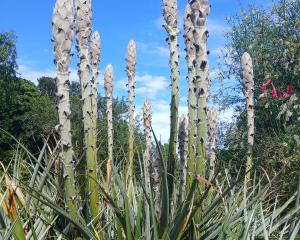
Last Friday, I was a guest at the Clinton Garden Club's 60th jubilee celebrations, a chance to reflect on what was grown in southern gardens in 1948.
Outdoors, the vege garden was the man's domain, although he sometimes grew special flowers for show, and the Presbyterian minister at Lawrence, the Rev E. B. (Breb) Stevenson, had great success with his daffodils at the Dunedin Horticultural Society's spring show in October 1948.
Judging by newspaper advertisements, peas and potatoes were the principal vegetables grown.
One supplier offered 11 named pea varieties, including Earlicrop, WF Massey, Greenfeast and Blue Bantam, while potatoes, as now, were sold as early, second early and main-crop varieties.
The still-popular Jersey Benne and Cliffs Kidney were among the early potatoes advertised, as was Epicure.
Second earlies on sale included King Edward and Chippewa.
Beans meant broad beans, the hardy Fava family, with Early Long Pod and Broad Windsor popular, while Scarlet Runner, and Dwarf French were the only tender Phaseolus types common in the South 60 years ago.
Advertised carrots included Coreless Wonder, and while Oxheart parsnips were promoted, I would be surprised if Hollow Crown was not grown, as it had been popular since its introduction in Europe in the 1850s.
I couldn't find any reference to yams, or oca, either.
In 1948, seed cost sixpence a packet, roughly equivalent to $3.50 today.
Seed potatoes were 3/6 a stone - about 6.5kg for $24.50 in modern terms.
There was a marvellous array of flowers available, either to grow from seed or by buying plants.
One Dunedin firm advertised dozens of flower varieties, including Pacific Giant delphiniums, Flash and Sunset Giant marigolds, Fluffy Ruffles petunias, phlox, Calendula, Dianthus, Artist's Glory Iceland poppies, snapdragons and Nemesia.
For the rose bed, everyone wanted Peace, released in 1945.
Other popular hybrid tea roses were the dark red Etoile de Hollande, still well worth growing for its perfume; Shot Silk and the lovely pink Elizabeth of York, named after the wife of Henry VII.
Toxic nicotine sulphate, sold as Black Leaf 40, was used to spray roses and many other plants, while among other nasties cheerfully recommended by garden writers were arsenate of lead to kill codlin moth and grass grub, formaldehyde as an insecticide and formalin to treat potato scab.
DDT, introduced into New Zealand in 1945, seems not to have been in widespread use by home gardeners in 1948.
Occasions such as the Clinton Garden Club's 60th jubilee celebrations highlight the strength of gardening in Otago and Southland, and, as those at the function noted, it is encouraging to see the rising interest in gardening by young people.












